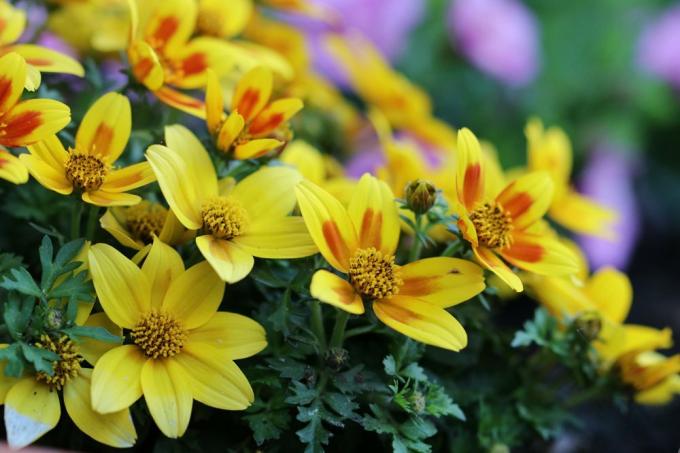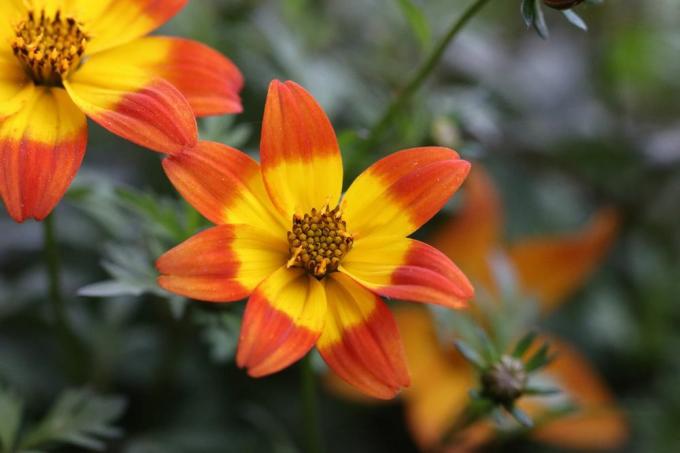
table of contents
- Characteristics
- species
- Location
- floor
- planting
- Care instructions
- to water
- Fertilize
- Cut
- Overwinter
- Multiply
- Pests
- Choose your planting partner well
Profile and care information open +conclude -
- Flower color
- yellow, multicolored, orange, red
- Location
- Sunny, full sun
- Heyday
- May, June, July, August, September, October
- Growth habit
- upright, bushy, overhanging
- height
- up to 40 cm high
- Soil type
- stony, sandy, loamy, gravelly, clayey
- Soil moisture
- moderately moist, fresh
- PH value
- weakly sour, sour
- Limescale tolerance
- Calcium tolerant
- humus
- rich in humus
- Poisonous
- no
- Plant families
- Asteraceae
- Plant species
- Bedding plants, Potted plants, Balcony plants
- Garden style
- Flower garden, roof garden, terraced house garden, allotment garden
The Goldmarie 'Bidens ferulifolia' also known as two-toothed, is a perennial and one of the most thankful summer bloomers, with more than 250 varieties worldwide. This attractive plant owes its name 'two-tooth' to its toothed fruits. Its yellow, orange, reddish or two-tone flowers develop a lush pile that sets colorful accents in beds, bowls, pots or hanging baskets. The abundance of flowers continues from spring to autumn.
Characteristics
- Plant family: Asteraceae
- Botanical name: Bidens ferulifolia, Bidens hybrids
- German names: Zweizahn, Goldmarie, Goldkosmos, Goldfieber, Gold-Zweizahn, Bidens
- Origin: Central and North America
- Habit: Annual to persistent, herbaceous, upright bushy to overhanging
- Height: 20 to 40 cm
- Flower: cup-shaped, yellow, orange, red, yellow-orange, red-orange, red-yellow
- Flowering period: May / June to September / October
- Leaf: green, pinnate or undivided
- Location: sunny
- Lime tolerance: lime compatible
- Toxicity: no indication of incompatibilities
species
Bidens 'Beedance (R) Painted Red'
This relatively new, very vigorous variety produces a multitude of bright orange flowers from June to October. In height and width it reaches 30-40 cm.
Goldmarie 'Blazing Glory'
Blazing Glory is a blooming, well-growing summer bloomer with half-double, two-tone flowers in flaming orange, yellow, red and rust tones. They appear from April through October. Their growth is bushy and overhanging.

Bidens' Yellow Sunshine (R) ‘
The large golden yellow flowers of 'Yellow Sunshine (R)' shine with the sun from May to October. It develops a compact, spherical shape with a slightly hanging habit and heights of 30-40 cm.
Bidens ferulifolia 'Orange Yellow Center'
This two-tooth from the 'Hawaiian Flare (R)' series is a novelty with an extraordinary color. Its flowers are bright orange with a reddish color gradient. From an initially compact growth, slightly overhanging, flower-strewn shoots develop. The height is between 35 and 40 cm.
Bidens ferulifolia 'Tweety'
Special bright spots in the bed or on the balcony are the double, bright yellow flowers of the 'Tweety' variety, up to 5 cm in size. In contrast to other varieties, this globular growing Goldmarie has no displacing effect.
Bidens ferulifolia 'Golden Empire'
The Goldmarie 'Golden Empire' impresses with a uniform, upright growth and an abundance of medium-sized, intensely yellow flowers. It grows 30-60 cm in height and width.
Bidens ferulifolia 'Bellamy White'
'Bellamy White' is a new, vigorous variety with broad, dark green leaves that are covered in countless white flowers from spring to autumn. With a height of 15-30 cm, this long, creeping, permanent bloomer remains a bit smaller.
Bidens ferulifolia 'Taka Tuka'
This attractive, between 35 and 40 cm high gold marie shines from April to September in a sea of small, star-shaped, golden-yellow flowers with cream-colored tips. They form a wonderful contrast to the dark green foliage.
Location

If you want to do something good for the two-tooth, you should treat it to a location in full sun. Long shoots that are covered over and over with flowers develop quickly in sunny locations. A sunny to partially shaded place is also possible. However, the weaker the solar radiation, the less the flower formation. In the partial shade, the flower is rather poor and hardly present in the shade. The Zweizahn can go outside from mid-May at the earliest, as soon as night frosts are no longer to be expected.
floor
In addition to a sunny spot, this permanent bloomer prefers a permeable, humus-rich and nutrient-rich soil with a pH value between 5 and 6. The permeability can be improved by adding sand, grit or humus. Normal garden soil is usually sufficient. A structurally stable, commercially available gardening soil, preferably with a clay content and the appropriate pH value, is suitable for keeping in a pot or bucket. The substrate should be able to store water and nutrients well.
Tip: However, the soil and substrate should not be too permeable, otherwise there is a risk that a large part of the nutrients will be washed out when watering.
planting
- Planting in the bed after the Ice Saints, around mid-May
- Mix some humus with excavated earth before planting out
- It is best to plant on a cloudy day
- Maintain a planting distance of 20-30 cm
- Soil should already have a temperature of approx. 20 degrees
- Repot newly purchased Bidens immediately after purchase
- A sufficiently large planter is necessary for optimal development
- A soil volume of at least 2-3 liters is required per plant
- Lower volume can affect the development of the plant
- Maintenance costs would also increase
- Water Goldmarie before planting
- Put drainage in the new pot
- Fill in the substrate and insert the plant
- Press the soil on and water it
Care instructions

Basically the two-toothed tooth (Bidens ferulifolia) belongs to the annual and short-lived plants and has to be sown every year in spring. With a lot of luck and the right overwintering, it may well be possible to save them for a further year or two. Regardless of how long you want to cultivate a two-toothed tooth, this will not succeed without a minimum of care, although this summer bloomer is extremely easy to care for.
to water
Two teeth need an even supply of water. How often it has to be poured depends largely on the weather and the intensity of the sun's rays Location, the size of the plant and, especially in the case of potted or container plants, the size of the planter respectively. the volume of the earth.
- Earth resp. The substrate should always be slightly moist
- Should neither dry out nor be waterlogged
- It is best to water early in the morning or in the evening
- Only pour onto the root area, not over leaves or flowers
- Recommended for balcony planting, flower boxes with water storage
- Water level indicator shows when water needs to be topped up
- Ensure that the water drains well in conventional flower boxes
- Remove residual water in the coaster
- The two-tooth reacts to a lack of water by shedding flowers
Fertilize
Regular fertilizers are essential for long-lasting flowering. This is the only way for Goldmarie to keep adding new flowers throughout the summer. In the garden, it is advisable to give a liquid fertilizer every week, which is administered via the irrigation water. Or you can work a suitable slow-release fertilizer into the soil during planting. After 4-6 weeks you can top up with a liquid fertilizer. Freshly repotted plants do not have to be fertilized until the second year, as most of the commercially available ones Potting soil is pre-fertilized so that the plants are supplied with all the important nutrients for a certain period of time will. You can later use liquid fertilizer once a month.
Cut

In general, Bidens ferulifolia does not have to be cut, as they usually only grow as an annual anyway. Nevertheless, smaller pruning measures can be an advantage. For example, a slight pruning in July or August can stimulate the formation of new flowers and thus extend the flowering time, which is also promoted by regularly cleaning out wilted flowers will. Wilted flowers should also be removed for visual reasons. In addition, pruning the tips of the shoots, preferably in spring, can encourage more branched growth.
Tip: If necessary, shoots that are too long can be shortened. But then you have to accept a two-week break from blooming.
Overwinter
The gold two-toothed tooth is usually sown anew every year, pulled as a cutting or sold as a young plant. If the plant is to grow and thrive for another year, it is in principle possible to overwinter it, even if this is not always successful. Specimens that are cultivated in pots or tubs are best suited for this. Preparations can already be started in late autumn by cutting the plant down to about a third.
The clippings can be used very well to obtain cuttings. Then you place them in a bright winter quarter with temperatures around 15 degrees. During the winter, there is only moderate watering. The pad should not dry out. In the following spring, if necessary, it can be cut back further and repotted in fresh substrate. After the ice saints she can go outside again.
Tip: As a rule, it is easier to bring a cutting cut in the fall through the winter than a full-grown plant.
Multiply

sowing
Sowing is possible from January / February. The earlier it is sown, the earlier the first flowers appear. The seeds required can be obtained from withered flowers in autumn or purchased from specialist gardeners.
- For sowing, fill the seed container with seed compost
- Spread the seeds on top
- Cover lightly with soil
- The substrate should have a temperature of 18-22 degrees
- Cover the seed pot with translucent foil
- Put the whole thing in a bright place with room temperature
- Average germination time is around two weeks
- Separate seedlings from a size of 4-5 cm
- Before moving outside, first choose a shady place
- Gradually get used to the sun
Cuttings
Cuttings can be cut in the fall. They should be 10-15 cm long. You put them in small pots with potting soil and then put them in a bright and warm place in the house. The substrate should be evenly moist and not dry out. In the spring, roots have usually formed so that the young plants can be transplanted if necessary. For a bushier growth, it is advisable to put around three plants in a pot.
Pests
Aphids
Under unfavorable conditions, aphids or whitefly infestations can occur. Spraying with a powerful jet of water usually helps against aphids. The whitefly can be found outdoors with yellow stickers and indoors with systemic anti-sucking agents insects to grapple.
Choose your planting partner well
The Gold-Zweizahn cuts a fine figure both in solo performances and in combination with other plants. When choosing the planting partner, its vigor must be taken into account. It is best to choose plants that grow similarly so that they do not overgrow one another. Combining it with another two-tooth variety can be an eye-catcher.
As a traffic light plant, it can be arranged well with the blue fan flower or other high-contrast two-tooth varieties. In window boxes you should avoid vigorous varieties and use more compact ones. Combinations with verbenas, hanging geraniums, Magic bells, Licorice straw flower or Hanging petunias at. The gold two-toothed tooth is also ideal for underplanting small trunks.



